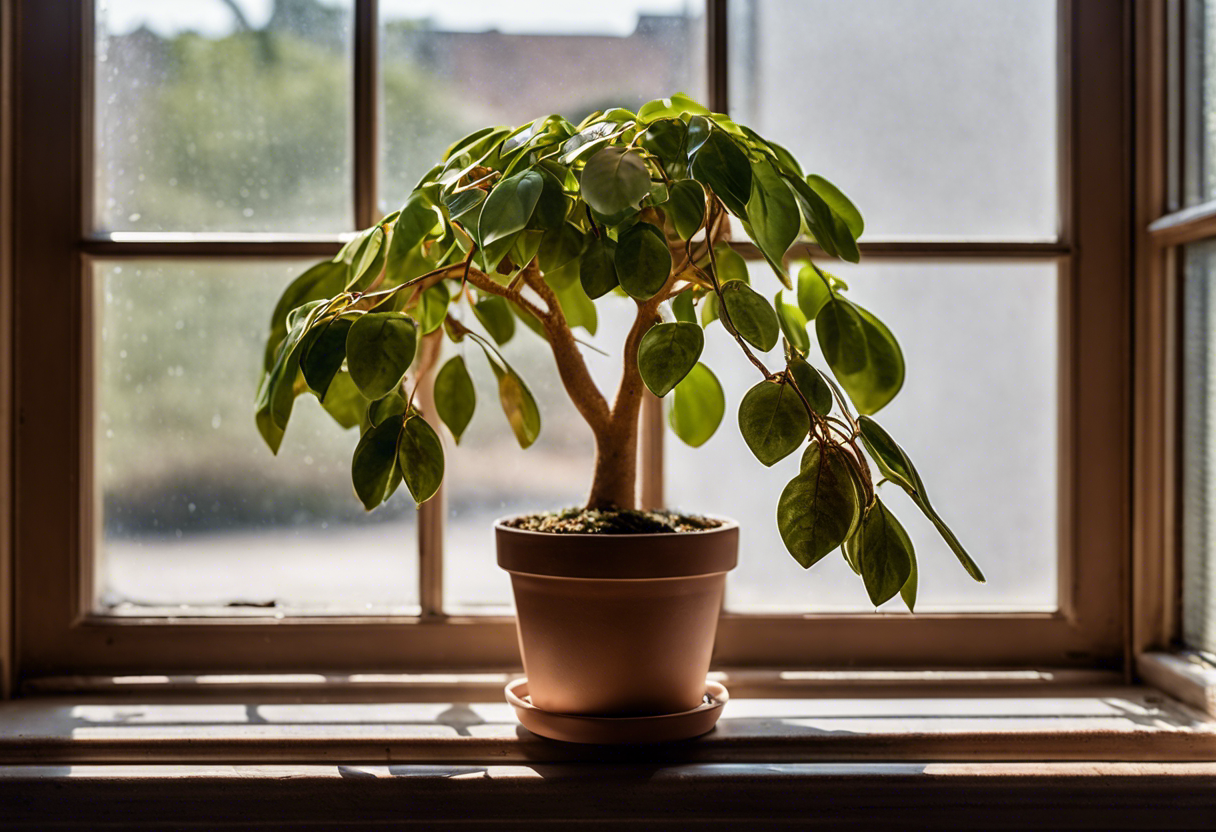Ever found yourself staring helplessly at your wilting Money Tree, wondering why it’s losing its charm? Been there, done that! But don’t worry, I found out How to Revive a Dying Money Tree and I’m here to share the secrets with you.
So sit back, relax and get ready for some plant CPR. We’re about to breathe life back into your green buddy. Keep reading about How to Revive a Dying Money Tree. Trust me, it’s easier than you think!
Key Takeaways
- Identify signs of a dying money tree, such as yellowing leaves or stunted growth.
- Overwatering is a common cause; ensure the plant’s soil is well-draining and only water when the top inch of soil is dry.
- Provide indirect sunlight and maintain temperatures between 60-85°F.
- Fertilize every two weeks during growing season with a balanced houseplant fertilizer.
- Prune dead or dying branches to promote new growth.
- Repotting may be necessary if root rot has set in.
Understanding the Money Tree
The Money Tree, or as botanists call it, Pachira Aquatica, is more than just an indoor plant. It’s a symbol of prosperity and good fortune, deeply rooted in Feng Shui principles. But what happens when this lucky charm starts to fade? Let’s dive into the world of money tree plant care and learn how to recognize the signs of a dying money tree.
What is a Money Tree?
A Money Tree is a popular indoor plant, known for its braided trunk and lush, green leaves. Originating from Central and South America, it’s scientifically known as Pachira Aquatica. But don’t let that fancy name intimidate you! This little guy is quite low-maintenance.
In Feng Shui, it’s considered one of the most potent lucky plants. Its five-leafed branches are said to represent the five elements of nature – wood, fire, earth, metal, and water. Now that’s some heavy symbolism for such a humble houseplant!
Recognizing a Dying Money Tree
So how do you know if your money tree needs help? Well, there are several tell-tale signs that your green friend might be in trouble.
One common issue is yellowing leaves. If you notice your money tree turning into a gold mine (and not in a good way), it could be due to overwatering or poor drainage.
Another sign is leaf drop. It’s normal for some lower leaves to fall off as new ones grow at the top but if you’re finding more leaves on your floor than on your plant – Houston, we have a problem!
Lastly, root rot can also signal trouble in paradise. If your plant has mushy or black roots instead of healthy white ones – it’s time to take action! Remember: learning how to revive a dying money tree starts with recognizing the problem.
Causes of a Dying Money Tree
When it comes to money tree problems, there are several culprits that could be causing your green buddy to kick the bucket. Let’s delve into some of these causes for money tree death and see if we can pinpoint what’s going wrong.
Inadequate Watering
First up, we have watering issues. Now, you might think giving your plant a good ol’ drench is the way to go, but hold up! Overwatering and underwatering both pose threats to your money tree.
Overwatering a money tree can lead to root rot, while underwatering a money tree can leave it parched and wilting. It’s all about balance here folks! Your money tree needs just the right amount of H2O to thrive.
Poor Lighting Conditions
Next on our list of possible money tree problems is poor lighting. These plants aren’t big fans of the spotlight, so blasting them with direct sunlight isn’t going to do them any favors.
On the flip side, keeping them in constant darkness isn’t great either. The key here is finding that sweet spot where they get enough indirect light – that’s what ticks their boxes when it comes to money tree light requirements.
Incorrect Temperature
Thirdly, we’ve got temperature troubles. Just like Goldilocks, your money tree wants its environment ‘just right’. Too hot or too cold and you’ll start seeing those dreaded dying money tree symptoms.
The ideal temperature for these little guys falls between 60-85°F (15-29°C). Anything outside this range could cause stress and harm their health – not cool!
Lack of Nutrients
Last but certainly not least, nutrient deficiencies can also cause your beloved plant to suffer. Your money tree needs certain nutrients to grow strong and healthy.
If it’s not getting enough of these essential goodies, you might start seeing signs of a nutrient deficiency. So make sure your plant is getting its daily dose of essential nutrients for money trees to keep it happy and healthy!
Signs and Symptoms of a Dying Money Tree
When your money tree starts acting up, it’s essential to know the signs. Money tree problems can manifest in various ways, but the most common dying money tree symptoms include yellowing leaves, dropping leaves, and brown spots on leaves. These are clear unhealthy money tree signs that should prompt you into action.
Yellowing Leaves
One of the first things you might notice is yellowing leaves. This is often due to overwatering or lack of nutrients. When a money tree has too much water, its roots can become waterlogged and oxygen-starved, leading to leaf yellowing. This condition is known as chlorosis.
On the other hand, if your plant lacks certain nutrients like nitrogen or magnesium, it may also lead to yellowing leaves on money tree. In both cases, the health of your plant is at stake because leaves are crucial for photosynthesis – the process by which plants make food.
Dropping Leaves
Another symptom you might encounter is dropping leaves. Now this one can be quite alarming! It’s like your plant is saying “I give up!” But don’t panic just yet. Leaf drop in money trees can be caused by several factors including sudden changes in temperature or light conditions.
If your money tree losing leaves, it could be a sign that it’s not getting enough light or being exposed to drafts or drastic temperature fluctuations. This stress causes the plant to shed its foliage as a survival mechanism.
Brown Spots on Leaves
Lastly, if you see brown spots appearing on your money tree’s foliage, it’s time for some serious plant doctoring! These spots could indicate a fungal infection or result from sunburn if your plant has been exposed to direct sunlight for too long.
The presence of brown spots on money tree leaves affects its ability to perform photosynthesis effectively, which can further weaken an already stressed plant. Understanding these reasons for brown leaf spots in money trees is crucial in figuring out how to revive a dying money tree.
Reviving Techniques for a Dying Money Tree
When it comes to how to revive a dying money tree, there are several techniques you can use. These include adjusting watering practices, modifying light exposure, regulating temperature, and providing essential nutrients. All these are crucial in money tree care and can make a significant difference when trying to save your plant.
Adjusting Watering Practices
Overwatering or underwatering your money tree can cause serious harm. It’s like feeding someone too much food or not enough – neither is good! Overwatering often leads to root rot while underwatering can cause the leaves to droop and turn yellow.
The key is finding the optimal watering schedule for money trees. This usually involves letting the top inch of soil dry out before watering again. Remember, proper hydration for indoor plants is more about consistency than quantity.
Modifying Light Exposure
Light exposure plays a significant role in the health of your money tree. Too much direct sunlight can scorch the leaves, while too little light can stunt growth and lead to leaf drop.
To improve light exposure for indoor plants, place your money tree in a bright spot with indirect sunlight. If natural light isn’t sufficient, consider using grow lights as an alternative source.
Regulating Temperature
Temperature fluctuations can be detrimental to your money tree’s health. Just like us humans, these plants prefer a stable environment where they don’t have to deal with sudden changes in temperature.
Maintaining plant temperature indoors requires some attention but it’s not rocket science! Aim for a consistent temperature range between 65-75 degrees Fahrenheit during the day and slightly cooler at night.
Providing Essential Nutrients
Nutrient deficiencies can lead to plant decline faster than you’d think! If your money tree starts showing signs of nutrient deficiency such as yellowing leaves or slow growth, it might be time for some TLC with fertilizers or soil amendments.
Choose a balanced, slow-release fertilizer for indoor plants. This will provide the essential nutrients your money tree needs to thrive. Remember, healthy soil equals a healthy plant!
Preventive Measures to Keep Your Money Tree Healthy
When it comes to money tree care, an ounce of prevention is worth a pound of cure. Regular pruning, proper potting and repotting, and pest control measures are all part of the preventive maintenance needed for a healthy money tree.
Regular Pruning
Pruning your money tree isn’t just about aesthetics; it’s a vital part of indoor plant care. By trimming back overgrown branches, you encourage healthy plant growth. This process helps your money tree maintain its shape and promotes new growth.
Now, you might be wondering how to go about this whole “pruning” thing. Well, it’s pretty simple! Just remember not to go too crazy with the clippers. A little snip here and there will do the trick. And always make sure your tools are clean to avoid spreading any diseases.
Proper Potting and Repotting Techniques
Potting or repotting your money tree might seem like a daunting task, but trust me, it’s not as scary as it sounds! The right potting techniques can lead to a healthy root system, which is crucial for your tree’s overall health.
First off, choose a pot that provides good drainage – nobody likes soggy roots! Secondly, use well-draining soil specifically designed for indoor plants or money trees. It should be rich in nutrients but also light enough to allow water to pass through easily.
When repotting, be gentle with the roots and give them plenty of room to grow in their new home. Remember: happy roots equal a happy plant!
Pest Control Measures
Pests can be a real pain when trying to maintain a healthy indoor plant environment. But don’t worry; there are plenty of ways you can protect your beloved money tree from these pesky invaders!
Regularly inspecting your plant for signs of pests is a good start. If you do spot any creepy crawlies, don’t panic! There are many organic pest control methods available that can help you deal with the problem without harming your plant.
Remember, the key to how to revive a dying money tree often lies in prevention. So, keep an eye out for those pesky bugs and give your tree the care it deserves!
To Wrap Up
In the grand scheme of things, reviving a dying money tree is like nursing a hangover after a wild night out. It’s all about hydration, comfort, and a little TLC. Remember, your green buddy craves light, water, and well-drained soil to bounce back.
So next time you notice your money tree looking gloomy, don’t panic! Just follow our guide on How to Revive a Dying Money Tree and watch it spring back to life. After all, who said money doesn’t grow on trees?





